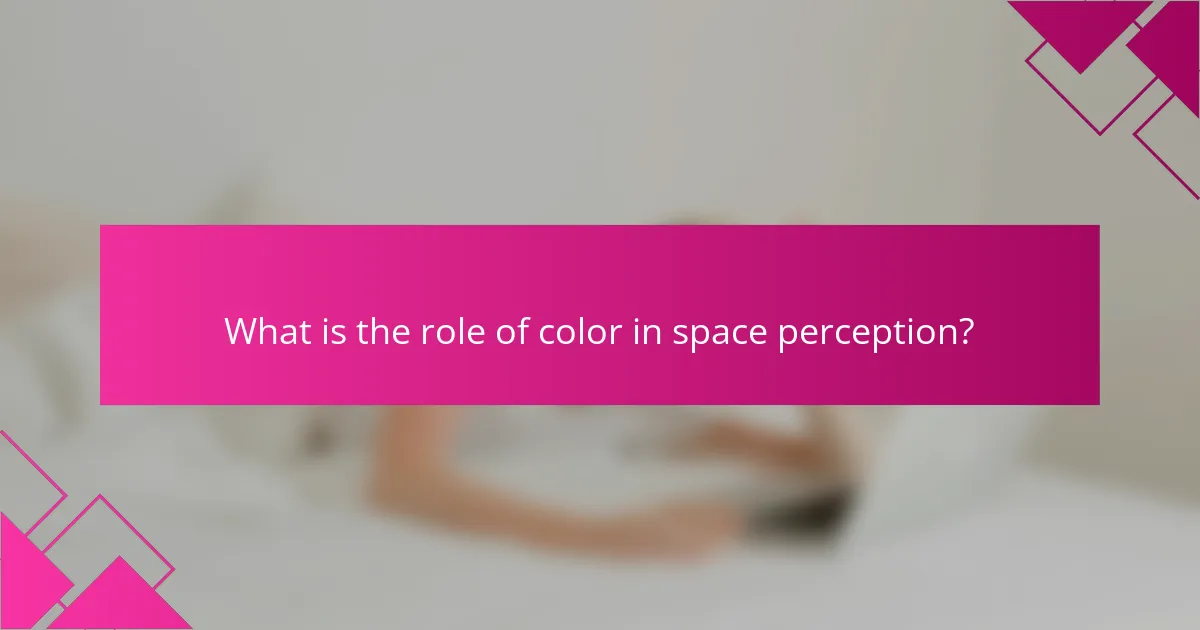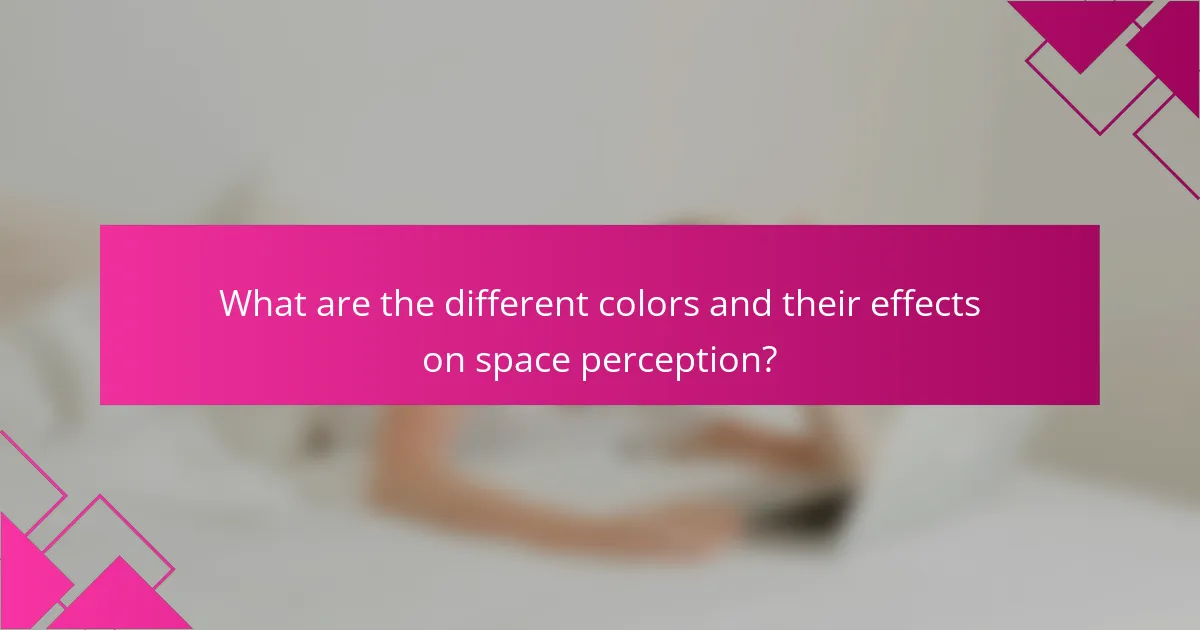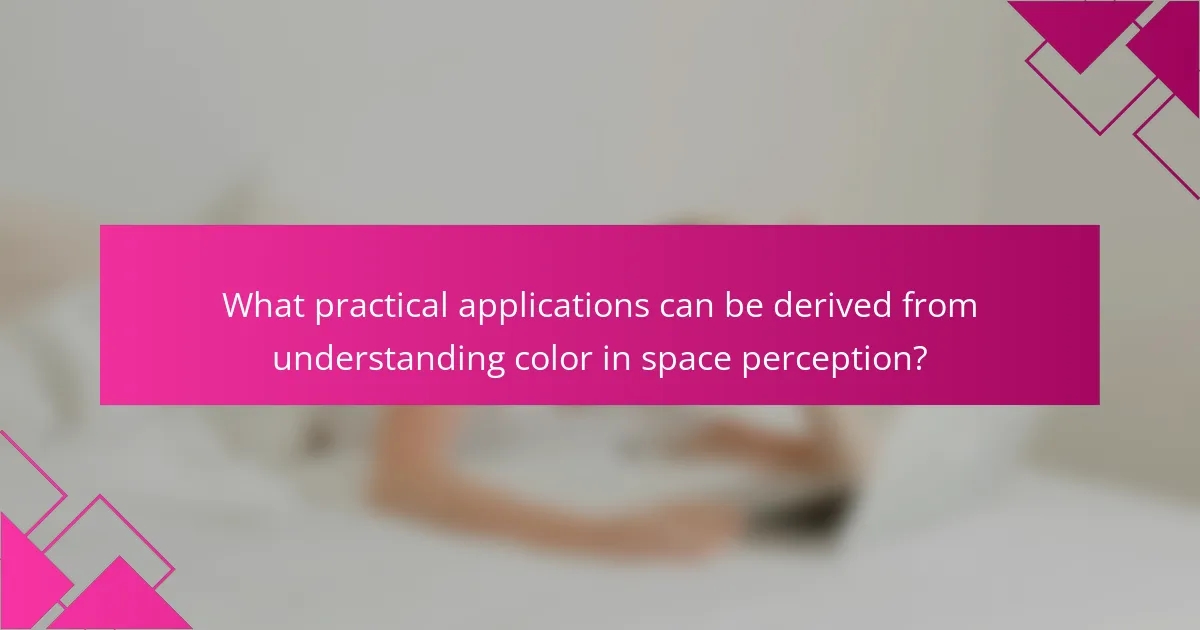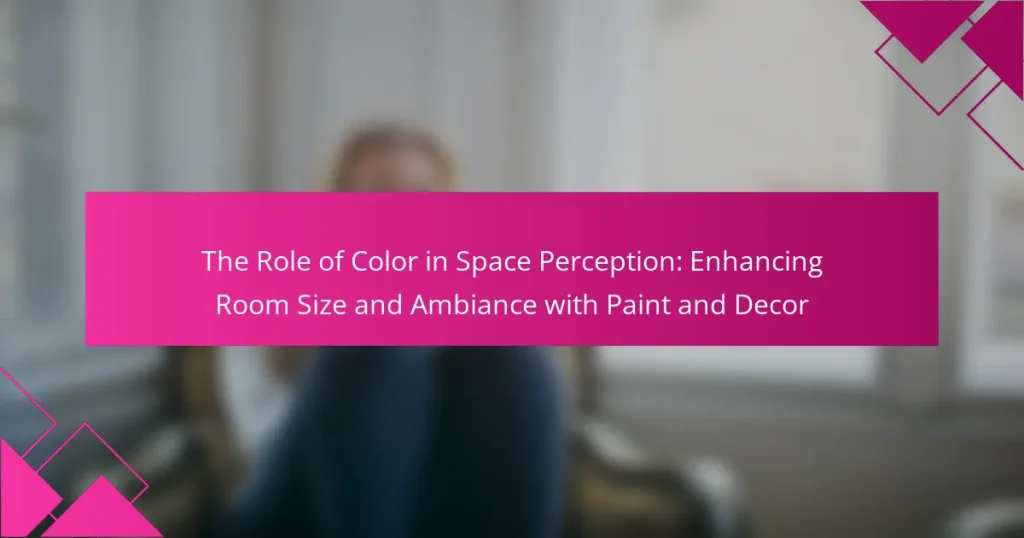Color significantly influences space perception, impacting how individuals perceive room dimensions and ambiance. Lighter colors create an illusion of larger, more open spaces, while darker colors foster intimacy and coziness. Research from environmental psychology shows that warm colors can enhance energy and warmth, whereas cool colors promote calmness and spaciousness. Understanding the effects of color is essential for interior design and architecture, as it directly affects mood, cognitive performance, and emotional responses. This article explores the role of color in shaping room size and ambiance through effective paint and decor choices.

What is the role of color in space perception?
Color plays a crucial role in space perception by influencing how we perceive the dimensions and ambiance of a room. Different colors can create illusions of depth and size. For example, lighter colors tend to make spaces feel larger and more open. In contrast, darker colors can make a room feel cozier but smaller. Studies in environmental psychology show that color can affect mood and perceived temperature. Warm colors like red and yellow can create a sense of warmth and intimacy. Cool colors like blue and green can evoke calmness and spaciousness. The choice of color directly impacts how we experience and navigate our environments.
How does color influence our perception of room size?
Color influences our perception of room size by creating visual illusions that affect spatial awareness. Lighter colors tend to make a room feel larger and more open. This is due to their ability to reflect more light. Conversely, darker colors can make a space feel smaller and cozier. Research indicates that colors such as soft blues and greens can enhance the perception of depth. A study published in the journal “Color Research and Application” found that lighter hues increase perceived spaciousness. The use of monochromatic color schemes can also create a seamless look, further enhancing the sense of space. Thus, color choice is crucial in interior design for manipulating room perception.
What psychological effects do colors have on space perception?
Colors significantly influence space perception. Warm colors, like red and yellow, can make a space feel smaller and cozier. Cool colors, such as blue and green, tend to create an illusion of spaciousness. Bright colors can enhance feelings of openness, while darker shades may evoke a sense of confinement. Research shows that light colors reflect more light, contributing to a perception of larger spaces. In contrast, dark colors absorb light and may visually reduce the size of a room. Additionally, color combinations affect mood and emotional responses, further altering perceptions of space. For instance, a monochromatic color scheme can create harmony and a sense of continuity in a room.
How do light and color interact to affect perceived dimensions?
Light and color interact to influence perceived dimensions by altering visual perception. Bright light can make a space feel larger by reducing shadows and enhancing visibility. Conversely, dim lighting may create a sense of enclosure, making areas appear smaller. Color temperature also plays a role; warm colors tend to advance visually, while cool colors recede. This receding effect can create an illusion of depth, enhancing the perception of space. Studies show that lighter colors reflect more light, contributing to a more open atmosphere. Darker colors absorb light, which may lead to a more confined feeling. These principles are foundational in interior design, impacting how spaces are experienced.
Why is ambiance important in interior design?
Ambiance is crucial in interior design because it influences the mood and experience of a space. A well-crafted ambiance can evoke emotions, create comfort, and enhance functionality. For example, warm colors and soft lighting can create a cozy atmosphere, while cool tones and bright lights can promote energy and focus. Studies show that environment significantly affects human behavior and well-being. Research from the Journal of Environmental Psychology indicates that spaces designed with attention to ambiance can increase productivity and satisfaction. Therefore, effective ambiance design is essential for achieving desired emotional responses and enhancing overall space perception.
What elements contribute to the overall ambiance of a room?
The overall ambiance of a room is influenced by several key elements. These include color, lighting, furniture arrangement, decor, texture, and sound. Color sets the mood and can make a space feel warm or cool. For example, soft blues and greens create a calming effect, while vibrant reds and yellows can energize a room.
Lighting affects how colors are perceived and can highlight textures and decor. Natural light creates an open feel, while warm artificial light can add coziness. Furniture arrangement impacts flow and functionality, contributing to comfort and accessibility.
Decor items, such as artwork and plants, add personality and interest. Texture, from fabrics to surfaces, enhances sensory experience and visual appeal. Sound, whether from music or ambient noise, can also influence how a space feels. Together, these elements shape the overall ambiance, creating a cohesive atmosphere.
How can color choices enhance or detract from a room’s ambiance?
Color choices significantly impact a room’s ambiance. Warm colors like reds and yellows can create a cozy and inviting atmosphere. Cool colors such as blues and greens tend to promote calmness and relaxation. Light colors can make a room feel larger and more open, while dark colors can create a more intimate or enclosed space.
Research shows that color can influence mood and behavior. For example, a study by the University of California found that colors can evoke emotional responses. In a workspace, blue hues can enhance productivity, while warmer tones can encourage social interaction.
Additionally, the saturation and brightness of colors also play a role. Bright colors can energize a space, while muted tones can create a serene environment. Therefore, selecting appropriate colors is essential for achieving the desired ambiance in any room.

What are the different colors and their effects on space perception?
Different colors significantly affect space perception. Light colors like white and pastels create an illusion of larger spaces. They reflect more light, making rooms feel airy and open. Dark colors, such as navy or deep red, tend to make spaces feel smaller and cozier. These colors absorb light, which can create a sense of intimacy.
Cool colors, including blue and green, are known to evoke calmness. They can make spaces feel more expansive and serene. Warm colors like yellow and orange can stimulate energy. They often make spaces feel inviting but can also appear to close in a room.
Research indicates that colors can influence mood and perception of space. For instance, a study published in the Journal of Environmental Psychology shows that color can alter perceptions of room size and ambiance.
How do warm colors affect room size perception?
Warm colors can make a room feel smaller. These colors, such as reds, oranges, and yellows, create a sense of closeness. They tend to advance visually, which can compress the perceived space. Research shows that warm colors influence spatial perception by altering the viewer’s emotional response. A study published in the journal “Color Research and Application” found that warm hues evoke feelings of warmth and intimacy. This emotional response can lead to a perception of reduced space. In contrast, cool colors like blues and greens generally create an expansive feeling. Therefore, the choice of warm colors can significantly impact how one perceives room size.
What are the characteristics of warm colors?
Warm colors are hues that evoke feelings of warmth and energy. These colors typically include red, orange, and yellow. They are associated with sunlight, fire, and heat. Warm colors can create a sense of intimacy and comfort in a space. They often stimulate emotions and can make a room feel cozier. Additionally, warm colors tend to advance visually, making spaces appear smaller. This characteristic can influence how room size is perceived. Studies show that warm colors can enhance feelings of excitement and enthusiasm.
In what scenarios are warm colors most effective in enhancing space?
Warm colors are most effective in enhancing space in scenarios where a cozy and inviting atmosphere is desired. These colors, such as reds, oranges, and yellows, can create a sense of warmth and intimacy. They are particularly useful in living rooms, dining areas, and bedrooms, where comfort is key. Warm colors can also make large spaces feel more intimate and smaller spaces feel more inviting. Research indicates that warm colors can stimulate conversation and social interaction, making them ideal for communal areas. Studies show that these colors can influence mood and perception, enhancing the overall ambiance of a room. For example, a study published in the Journal of Environmental Psychology highlights how warm colors can increase feelings of comfort and safety.
How do cool colors influence the perception of space?
Cool colors, such as blue and green, create an illusion of spaciousness in a room. These colors tend to recede visually, making walls appear further away. This effect can enhance the perception of depth in a space. Studies show that lighter shades of cool colors amplify this spacious feeling. For example, a pale blue can make a small room feel larger. In contrast, warm colors tend to advance, making spaces feel cozier but smaller. The use of cool colors is often recommended in design for compact areas. This principle is supported by color theory and psychological studies on color perception.
What are the defining traits of cool colors?
Cool colors are characterized by their calming and soothing qualities. They typically include shades of blue, green, and purple. These colors evoke feelings of tranquility and relaxation. Cool colors are often associated with nature, such as water and foliage. They can create a sense of spaciousness in a room. This effect can make areas feel larger and more open. Studies show that cool colors can lower heart rates and reduce stress. Their use in interior design can enhance overall ambiance and comfort.
When should cool colors be used to create an illusion of space?
Cool colors should be used when aiming to create an illusion of space in a room. These colors, such as blues and greens, recede visually, making walls appear further away. This effect is particularly effective in small or cramped areas. Using cool colors on walls can enhance the perception of depth in a space. Studies in color theory support this approach, indicating that cool tones create a calming atmosphere. They are ideal for bedrooms, bathrooms, and any area where a sense of spaciousness is desired. Additionally, cool colors can be paired with warmer accents to maintain balance while still achieving the illusion of more space.

What practical applications can be derived from understanding color in space perception?
Understanding color in space perception has practical applications in interior design and architecture. Color influences how individuals perceive room size and ambiance. Lighter colors can make spaces appear larger and more open. Darker colors can create a sense of intimacy and coziness.
Designers often use color to manipulate mood and functionality in a room. For instance, blue hues can promote calmness, while warm colors like red can stimulate energy. Research shows that color can affect cognitive performance and emotional responses. A study by the University of California found that color choices significantly impact mood and productivity in workspaces.
These insights allow professionals to create environments tailored to specific activities and emotional responses. Thus, understanding color in space perception is essential for effective design strategies.
What are the best color combinations for small rooms?
Light colors such as soft whites and pale pastels are the best color combinations for small rooms. These colors reflect more light, making the space feel larger and more open. Complementary shades like light gray with white trim can add depth without overwhelming the senses. Additionally, using a monochromatic color scheme can create a cohesive look. For instance, varying shades of blue can evoke a calm atmosphere while maintaining a sense of space. Accent colors in moderation, like a soft yellow or gentle green, can enhance the overall aesthetic without making the room feel cramped. According to interior design experts, these combinations effectively maximize the perception of space in small areas.
How can light colors be used to create a sense of openness?
Light colors can create a sense of openness by reflecting more natural light. This reflection helps to brighten a space, making it feel larger and more inviting. Light colors, such as whites, pastels, and soft neutrals, visually expand the boundaries of a room. Research shows that lighter hues can enhance the perception of space by minimizing shadows and creating a seamless flow. A study published in the Journal of Environmental Psychology confirms that light colors influence spatial perception positively. Additionally, using light colors on walls and ceilings can create an airy atmosphere, contributing to a feeling of freedom and comfort.
What role does contrast play in defining room boundaries?
Contrast plays a crucial role in defining room boundaries. It helps distinguish different areas within a space. For example, varying colors or textures can create visual separations. High contrast between walls and furniture emphasizes distinct zones. This method enhances spatial awareness and organization. Research shows that contrast influences how we perceive room dimensions. Studies indicate that well-defined boundaries can make spaces feel larger or more intimate. Thus, effective use of contrast is essential in interior design for clarity and functionality.
What tips can enhance room ambiance through color choices?
Choose lighter colors to create a sense of openness. Light hues reflect more light, making spaces feel larger. Use warm tones to add coziness and comfort. Warm colors like soft yellows and oranges can evoke warmth. Incorporate accent walls to add depth and interest. An accent wall in a bolder color can create a focal point. Consider the room’s purpose when selecting colors. Calming colors like blues and greens work well in bedrooms. Use color to influence mood; bright colors can energize a space. Research shows that color can impact emotions and perceptions of space.
How can accessories and decor complement wall colors?
Accessories and decor can enhance wall colors by creating visual harmony. They can introduce complementary colors that balance or contrast with the wall shade. For example, a blue wall can be paired with orange accents, which are opposite on the color wheel. This contrast draws attention and adds vibrancy to the space.
Textures in accessories also play a role. A matte wall can be paired with glossy decor to create depth. Patterns in textiles can echo the wall color, reinforcing the overall theme. Additionally, varying sizes of decor elements can create a dynamic visual interest against a solid wall color.
Strategically placed accessories can also guide the eye, making a room feel larger or cozier. For instance, lighter decor can make darker walls feel less imposing. Overall, the careful selection of accessories and decor can significantly enhance the perception of wall colors in a room.
What common mistakes should be avoided when selecting colors for space perception?
Common mistakes to avoid when selecting colors for space perception include using dark colors in small rooms. Dark colors can make spaces feel cramped and uninviting. Another mistake is overlooking the effect of lighting on color. Natural and artificial light can drastically alter how colors appear. Failing to consider color harmony is also a critical error. Clashing colors can disrupt the flow and ambiance of a space. Additionally, ignoring the purpose of the room can lead to poor choices. For example, calming colors are preferable in bedrooms, while vibrant colors may be suitable for play areas. Lastly, neglecting to test paint samples in the actual space can result in unexpected outcomes. Colors can look different on walls than they do on a paint chip.
The primary entity of this article is the role of color in space perception, specifically how it influences room size and ambiance through paint and decor choices. The article examines how different colors can create visual illusions that affect spatial awareness, with lighter colors making spaces feel larger and darker colors creating a cozier atmosphere. It also discusses the psychological effects of color on mood and perception, the interaction between light and color, and practical applications of color theory in interior design. Key insights include the importance of color combinations, the impact of warm and cool colors on space perception, and tips for enhancing room ambiance through effective color selection.


